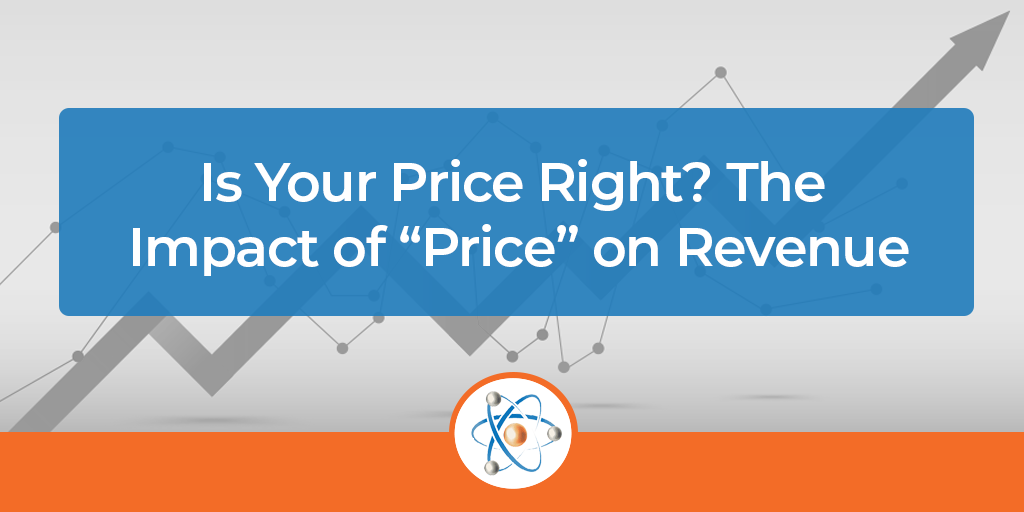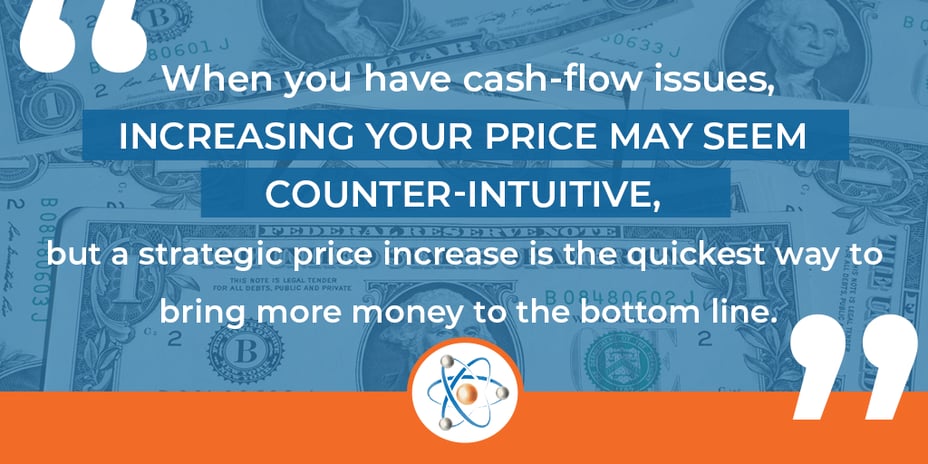
As a Partner at B2B CFO® and trusted Business Advisor, one of the most common questions I hear and areas of uncertainty with my clients surrounds “price.” As business owners, we have so many worries when it comes to pricing. Is my price too high? Is my price too low? Will I be able to underbid my competitor? How do I set a pricing strategy?
How much money did I leave on the table? Do I have enough money to cover my company’s bills and payroll? The greatest impact on your revenue comes from the price you set for your product. You must have the right pricing strategy for your business model. Your price determines your ability to be successful, generate cash, and increase the profitability of your business. Is your price right?
How Price Effects Your Business
Everything starts with price. One of the most common pitfalls is not understanding how it directly affects all areas of your business. Poor pricing strategy adversely affects cash flow. When a business sets prices too low, there will be trouble covering monthly expenses, the cost of inventory or software, and payroll. Businesses that cannot cover these costs will soon be out of business, which leads to one of the first things I ask my clients with cash-flow issues, “when was the last time you had a price increase?”

Begin with Your Pricing Strategy
To successfully increase your price enough to cover costs and grow revenue, first, you must determine how much to increase price and why, and then do it strategically, at the right time with clear communication to your customers. And do not let the fear of losing customers deter you – price increases are a fact of life in everything we do – grocery shopping, fuel for our vehicles, home goods, even medical needs. If your value is there, most of your customers will remain your customers. Here are a few pointers to begin the process of increasing your price.
Determine Your Breakeven Point
First, as a business owner, you need to know your business breakeven point. The breakeven point is where the profit for your business is zero. It tells you how much product or services you need to sell to cover all annual business costs. Annual business costs include the costs to make the product or services and wages and other monthly costs, such as rent and utilities. The breakeven point will quickly show which high-fixed costs or product costs your business must cover to make a profit. Every sale after the breakeven point contributes to the profitability of the business.
Once you know your breakeven point, determine if the amount of sales you need to make a profit at your current price makes sense based on what the business has sold in the past. If it is not enough, take your newly calculated information and implement an updated price that covers costs and adds to your gross margins. Your goal should always be to at least maintain, or if possible, increase your gross margins and net income each year.
Know When to Increase Price
The end of third quarter or start of Q4 is the best time to talk about and implement price increases. Your vendors are raising their prices. Your employees will want raises. And, quite frankly, your customers expect incremental increases to cover costs. Your monthly sales will be used to cover future costs, which is why you should increase your price as needed to help increase your profits and your company’s value. Let’s face it, no one is going to tell you that you need to raise your price. You are the one who must initiate it.
Solutions to Combat the Fear of Raising Price
Most business owners have concerns when they initiate a price increase or change pricing strategy, which is only natural and can be overcome. The main concerns and solutions to overcoming the fear of raising your price include:
1. "I will lose customers."
This typically only occurs when you must implement a major price adjustment to cover all the years you didn’t initiate a price increase. A customer receiving an annual 3% to 4% price increase is less likely to leave if you are still delivering value. When you push a major increase, say 15 to 20%, some may leave, but you can make up for the loss with your remaining customers and new business.
2. "My competition is not raising their price."
This may be true, but will they stay in business? Talk to your customers about why the price increase is being initiated. Explain where the money is going. “We have to pay 20% more for our product because of tariffs … One of our major suppliers initiated a 5% increase … We are actually helping you with your account 20% more than our other customers.” Take the time to tell your customers, in a friendly manner, that you value their business and explain the increase.
3. "My business has always run on low price."
It is time to get out of the low-price game. What do you offer that no one else does? Do you cut product to order? Do you sell in unusual quantities? Do you take returns, no questions asked? These are all valuable services. Small businesses are profitable when they don’t try to compete with big box stores. Sell your value, not your price.
Develop a Dependable Pricing Strategy
Lastly, I do not recommend a blanket price increase. For companies that have multiple SKUs, big box customers, high-priced, or high-volume products, you should develop a pricing strategy you can implement across your business. Look at your high-selling and/or high-profit-margin products and implement a price increase there; customers will be less likely to complain as they want and need those products. You may also want to consider lowering the price on low-selling items to move the inventory and make room for more profitable items (SALE!). If you offer a service, which service is your lost-leader? Phase it out and put your efforts into those that make the most margins. Look at your sales and margins to determine which items should be increased and which should be on clearance.
Sell Your Value and Price Will Be Justified
Do not underestimate your worth. You have proven that you offer a great service and/or products and have delivered value to your loyal customers. Your pricing strategy should reflect this. Inflation is part of life, people get that, and would rather you stay in business than leave them in a lurch trying to find another company that offers what you offer. Determine your business’s breakeven point, look at timing, create a pricing strategy, let go of the fear, and increase your price as needed. You will be so glad you did when you watch revenue soar!
Want to learn more about setting prices and how pricing influences your cash? Visit my website or contact me for a complimentary Discovery Analysis™ today, (618) 541-1197. If you would like to learn how you can launch revenue with end-to-end revenue production™, contact my strategic partner, Atomic Revenue for a free revenue assessment. We work together to grow our clients’ revenue, determine the best pricing strategy, and help them thrive in business.
NOTICE: B2B CFO® Partners, LLC, dba B2B CFO is an Arizona limited liability company that provides advisory and consulting services. B2B CFO® partners are independent contractors and are not officers, employees or agents of, or partners or joint ventures with, the companies they serve, nor are they independent CPAs.






